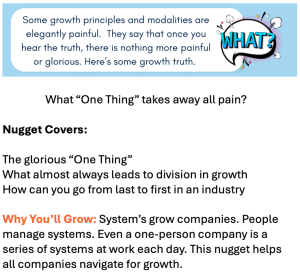7 Growth Must Dos
$23.00
These are plastered on walls throughout the world.
Most growth can be traced back to one to three key implementations or changes. This nugget is a grouping of some of the most famous “Key Implementations”,
“Growth Starters”, or “Tenets” found today. These chunks are responsible for trillions of dollars in today’s economy.
The guts of this nugget make up many of the core tenets of the fastest growing companies in U.S. history.

These are plastered on walls throughout the world.
Most growth can be traced back to one to three key implementations or changes. This nugget is a grouping of some of the most famous “Key Implementations”,
“Growth Starters”, or “Tenets” found today. These chunks are responsible for trillions of dollars in today’s economy.
The guts of this nugget make up many of the core tenets of the fastest growing companies in U.S. history.
(0:00 – 1:43)
I saw a one-liner that I circled, that I later brought back into my company and saw a physical impact in growth or savings. I’ve put it on a Microsoft Word document and I’m just going to kind of, I’m going to kind of elaborate on these and talk about these and again hopefully my experience, many of which these experiences were painful, and my experience of growth at the 80 employee level and pretty decent growth, especially the last five years. Hopefully, these lessons or these nuggets can impact some of you.
I’m going to start with the first one. This is definitely now a cliche, a business cliche, but like people say, there’s so much said in a joke, there is so much power in a cliche. A cliche is because it’s been repeated over and over and over.
So let’s start. Don’t expect what you don’t inspect. Don’t expect results if you’re not inspecting the process.
That phrase has hurt my company so badly in the years I’ve been running this that I used to hate that phrase tremendously. Now I love that phrase and I’ll give you a recent episode about a year ago. I had a meeting with their core management.
(1:43 – 3:22)
I said, guys, we have got to stop managing people. We have to start managing numbers. We’re talking to a group of highly right-brain, creative, strategic, internet marketing types of people.
They’re artists. They see things. They adapt.
They’re just creatives. And so for me to tell them that this is not optional, we’re officially instilling what are called flash reports. It was painful.
A flash report is simply where I now have 30 of our employees every single day. By the time they close down their day, they’ve logged into a dashboard. They’ve clicked a little button and it says, okay, today, or they can even do this as it’s happening.
I either created a piece of content. I created an infographic. I was able to build a link from say, you know, this big website to our website, or I was able to move a piece of content and get 50 social signals.
So basically what they do is they just make little bitty flash reports that show us what they’re doing each day. What you get to do is every 30, 60, 90 days, you can add up all these little scores basically and say, okay, on this website, these 11 people did these little projects and look at the growth of the site. We can basically work that backwards and diagnose exactly what went into that growth.
(3:23 – 4:09)
Then we can replicate that. Without the flash reports, we’ll see sites growing, but we won’t be able to microscopically say, well, what exactly went in there? So I basically instilled the flash report because I was sitting in a conference and I heard one more expert say, ‘Do not expect growth in areas where you’re not inspecting the process.’ I wrote it down.
I said, I’m not dealing with this anymore. That was, you know, a year ago. So it was, it was tremendous.


